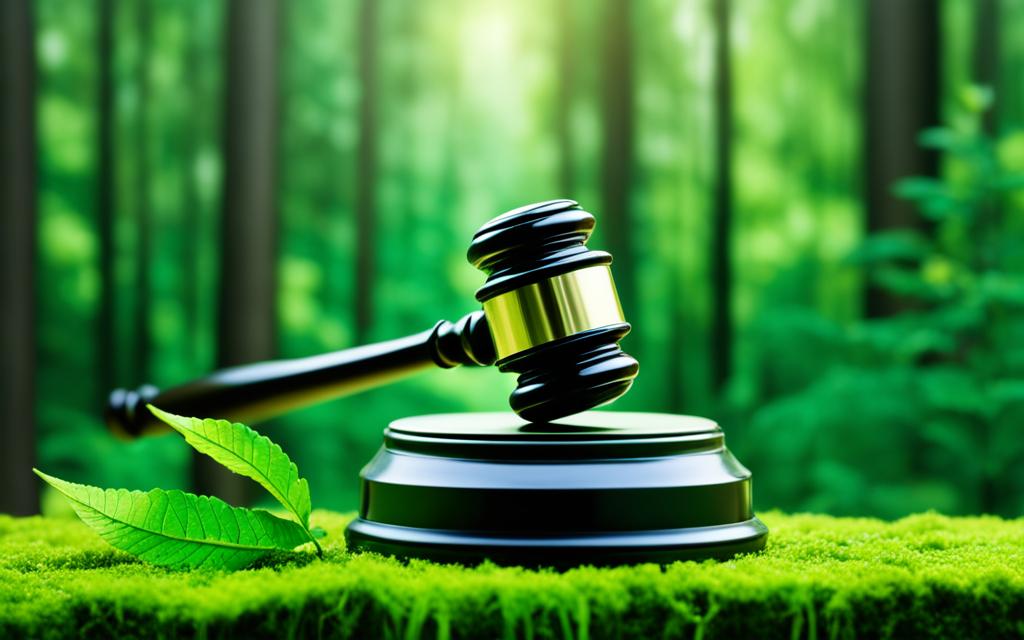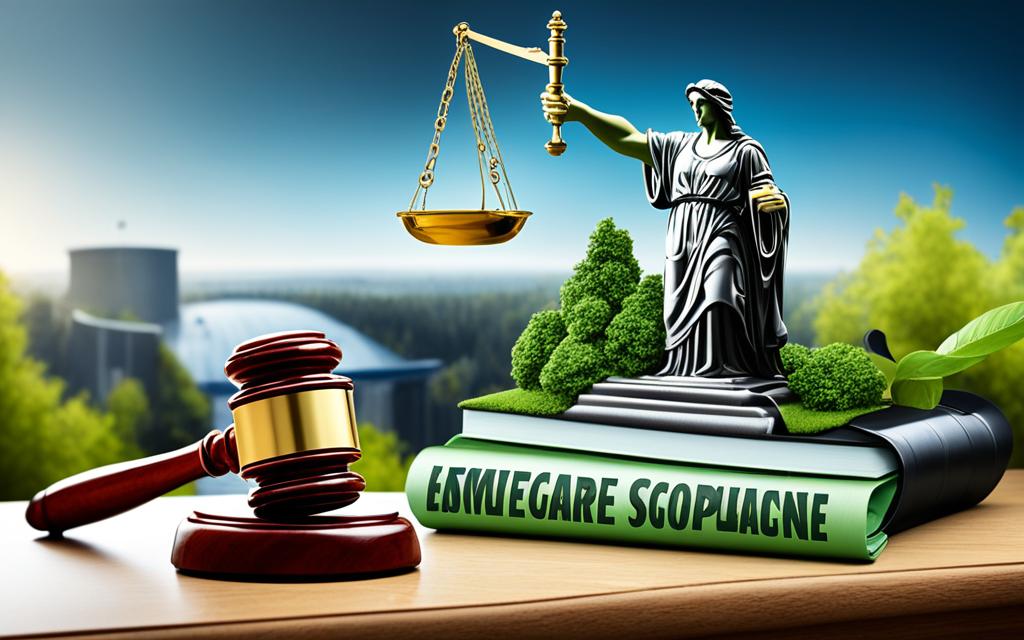Welcome to our comprehensive guide on the role of the judiciary in shaping environmental futures. In this article, we will explore the legal insights and impacts that play a crucial role in addressing environmental issues and promoting sustainability. Through the expertise of environmental law firms, compliance with environmental regulations, litigation services, and promoting sustainable business practices, the judiciary plays a vital role in ensuring a greener and more sustainable future.
Environmental issues are complex and require legal solutions that go beyond simple compliance. Environmental law firms specialize in providing comprehensive legal guidance to individuals and organizations striving to uphold environmental regulations while addressing practical challenges. These firms offer a range of services, including legal advice, representation, and strategic planning, to support sustainable initiatives and navigate complex legal frameworks.
Ensuring compliance with environmental regulations is a fundamental aspect of environmental stewardship. The judiciary plays a pivotal role in enforcing compliance by holding individuals and organizations accountable for violations. By upholding environmental regulations through litigation services, the judiciary ensures that the consequences of environmental harm are properly addressed, discouraging future non-compliance.
Sustainable business practices are essential for achieving long-term environmental sustainability. Environmental policy consulting plays a vital role in helping businesses develop and implement strategies that integrate environmental considerations into their operations. By providing guidance and expertise on environmental policies, the judiciary assists businesses in embracing sustainable practices that drive positive environmental outcomes.
Throughout this article, we will explore various aspects of the judiciary’s role in shaping environmental futures. From the emergence of environmental law and legal solutions for environmental issues to the intersections between environmental law and human rights, we will delve into the crucial connections that drive progress in environmental protection. We will also examine the influence of the judiciary on global environmental initiatives, the potential for an International Court of the Environment, and the transformative power of environmental public interest litigation.
Key Takeaways:
- Environmental law firms provide expert legal guidance for individuals and organizations seeking to address environmental issues and comply with regulations.
- The judiciary plays a vital role in enforcing compliance with environmental regulations, ensuring accountability for violations.
- Sustainable business practices are crucial for long-term environmental sustainability, and environmental policy consulting assists in integrating environmental considerations into business operations.
- The judiciary’s impact on environmental futures extends to global environmental initiatives, the potential for an International Court of the Environment, and the transformative potential of environmental public interest litigation.
- By understanding the judiciary’s role in shaping environmental futures, we can better appreciate the critical importance of legal insights and impacts in achieving long-term sustainability.
The Emergence of Environmental Law and Legal Solutions for Environmental Issues
In response to the escalating environmental challenges, the emergence of environmental law has played a crucial role in addressing these pressing issues. Environmental law has evolved over time with the aim of providing legal solutions for environmental problems and promoting environmental sustainability.
Environmental law encompasses a wide range of legal frameworks, regulations, and policies that seek to protect the environment and natural resources. It addresses issues such as pollution control, land use planning, biodiversity conservation, and climate change mitigation. Through the development and implementation of environmental laws, governments and regulatory bodies strive to balance economic development with environmental protection.
One significant aspect of environmental law is the expertise of legal professionals with a background in conservation law. These experts possess in-depth knowledge of environmental regulations and have the skills to advise individuals, organizations, and governments on legal strategies that promote sustainability and protect the environment.
Legal solutions for environmental issues are vital in ensuring effective environmental governance and sustainable development. These solutions encompass various areas, including compliance with environmental regulations, enforcement of environmental laws, and dispute resolution.
By integrating legal solutions into environmental sustainability efforts, we can ensure that environmental considerations are given the necessary legal and regulatory weight. Legal professionals with conservation law expertise can provide valuable guidance on navigating complex environmental issues and ensuring compliance with environmental regulations.
As the world faces ever-increasing environmental challenges, the emergence of environmental law and the implementation of legal solutions are critical in safeguarding our planet’s future. By working together to develop and enforce environmental laws, we can make significant strides towards a more sustainable and environmentally conscious world.
Intersecting Paths: Environmental Law and Human Rights
This section explores the intersecting paths of environmental law and human rights. The recognition and protection of environmental rights have become increasingly important in addressing environmental challenges and promoting sustainable development. Environmental issues can have a profound impact on individuals’ enjoyment of basic human rights, such as the right to life, health, and a clean and healthy environment.
Judicial Recognition of Environmental Rights
The judiciary plays a crucial role in recognizing and upholding environmental rights. Through their interpretation of laws and legal precedents, judges have the power to recognize the right to a healthy environment as a fundamental human right. Judicial recognition of environmental rights reinforces the legal framework for environmental protection, enabling individuals and communities to hold governments and corporations accountable for environmental harms. It also provides a basis for legal remedies and enforcement actions in cases of environmental violations.
Environmental Justice and Equity Considerations
Environmental justice is a concept that seeks to address the disproportionate distribution of environmental burdens and benefits among different communities. It emphasizes the need for fairness and equity in decision-making processes related to environmental policies, regulations, and projects. The judiciary plays a crucial role in ensuring equity considerations are taken into account in environmental decision-making. By considering the social, economic, and environmental impacts of policies and projects, judges can advocate for fair and just outcomes that uphold the rights and interests of marginalized communities.

It is essential to recognize the interconnectedness of environmental law and human rights to achieve sustainable and equitable development. Through judicial recognition of environmental rights and consideration of equity, the judiciary contributes to promoting environmental justice and ensuring that the rights of individuals and communities are safeguarded.
Global Environmental Initiatives and the Influence of the Judiciary
In today’s interconnected world, global environmental initiatives play a crucial role in addressing pressing environmental challenges. These initiatives aim to mitigate climate change, promote biodiversity conservation, and foster sustainable development. However, the successful implementation of these initiatives requires the active involvement of various stakeholders, including the judiciary.
The judiciary, with its authority and expertise, holds significant influence over global environmental initiatives. Through its decisions and actions, it shapes and implements international environmental governance frameworks. Judicial rulings set legal precedents that guide environmental policy-making and enforcement, providing clarity and direction to environmental initiatives at a global level.
In the context of climate change mitigation, the judiciary’s role is particularly critical. By interpreting and applying environmental laws and regulations, judges contribute to the development of effective strategies and policies to reduce greenhouse gas emissions. Their decisions have the power to hold governments and companies accountable for their environmental responsibilities, driving sustainable practices and stimulating innovation in the private sector.
Biodiversity conservation is another area where the judiciary’s influence is crucial. By adjudicating cases related to habitat destruction, wildlife trafficking, and other biodiversity-related issues, judges contribute to the protection and preservation of vulnerable ecosystems and species. Judicial decisions can create incentives for governments and communities to prioritize conservation efforts and adopt more sustainable practices.
It is important to note that the judiciary’s influence on global environmental initiatives goes beyond individual cases. Judges have the power to shape legal frameworks, interpret international agreements, and ensure compliance with environmental standards. Their role extends to advancing principles of environmental justice, equity, and sustainable development.
With their impartiality and commitment to upholding the rule of law, judges play a vital role in driving global environmental initiatives. Their decisions and actions provide the necessary legal foundation and enforcement mechanisms for achieving long-term environmental sustainability. The judiciary’s influence extends beyond borders, influencing environmental initiatives at both national and international levels.
| Benefits of Judiciary’s Influence on Global Environmental Initiatives | Examples of Judiciary’s Influence on Global Environmental Initiatives |
|---|---|
| Enhanced legal frameworks: Judicial decisions contribute to the development of robust legal frameworks that govern global environmental initiatives. | Landmark rulings: The Supreme Court of India’s decision to ban the sale of firecrackers in Delhi during Diwali to tackle air pollution. |
| Promotion of accountability: Through their decisions, judges hold governments, corporations, and individuals accountable for their environmental actions or inactions. | The Urgenda case: The Dutch Supreme Court’s ruling that the government has a legal obligation to reduce greenhouse gas emissions to protect its citizens from the harmful effects of climate change. |
| Strengthening international cooperation: Judicial decisions influence international collaboration and inspire other jurisdictions to adopt similar environmental initiatives. | The Colombian Amazon case: Colombia’s Supreme Court ruling that the Amazon rainforest is a legal entity with rights, inspiring similar legal actions across countries to protect vital ecosystems. |
| Promotion of sustainable practices: Judicial decisions contribute to the promotion of sustainable practices and the integration of environmental considerations into development plans and policies. | The Finnish peatland case: The Supreme Administrative Court of Finland’s ruling to protect peatlands from harmful activities, leading to the implementation of sustainable peatland management practices. |
The judiciary’s influence on global environmental initiatives is a testament to the vital role it plays in shaping a sustainable future. Judicial decisions and actions drive positive change, setting the stage for transformative environmental policies and practices. As we continue to face environmental challenges, it is imperative to recognize and support the judiciary’s role in advancing global environmental initiatives.
Project for an International Court of the Environment: Origins and Prospects
In addressing global environmental issues, there is a pressing need for an international environmental judiciary body that can provide effective resolution and oversight. The Project for an International Court of the Environment is a significant initiative aimed at establishing such a body. This section explores the origins and prospects of this project and its potential impact on international environmental governance.
Assessing the Need for an International Environmental Judiciary Body
The need for an international environmental judiciary body stems from the complex and interconnected nature of global environmental challenges. Existing national and regional environmental legal frameworks often fall short in addressing these issues comprehensively and consistently. By establishing an International Court of the Environment, we can ensure a unified and specialized approach to handling international environmental disputes, fostering global cooperation, and upholding environmental justice.
Challenges in Establishing a Global Environmental Court
The establishment of a global environmental court presents several challenges that need to be overcome. Jurisdictional issues, differing legal systems, and procedures across countries can hinder the efficient resolution of international environmental disputes. Additionally, the complexities of international environmental law, including the diverse range of environmental issues and the involvement of multiple stakeholders, require careful deliberation when designing the structure and processes of a global environmental court.
International environmental dispute resolution poses unique challenges. It requires a balance between ensuring impartiality, accessibility, and accountability while promoting the conservation and protection of the environment. The role of national courts, regional tribunals, and other relevant bodies needs to be harmonized and coordinated to facilitate effective and timely resolution of international environmental disputes.
Nonetheless, despite these challenges, the establishment of an International Court of the Environment holds great potential in achieving meaningful progress in global environmental governance. By consolidating expertise, providing a platform for international cooperation, and ensuring the adherence to environmental principles and standards, such a court can contribute significantly to the preservation and sustainable management of our planet.
Environmental Compliance and Enforcement: The Judicial Perspective
In the realm of environmental law, the judiciary plays a crucial role in ensuring environmental compliance and enforcing regulations. Judges have the responsibility of interpreting and applying environmental laws to hold individuals and organizations accountable for their actions that harm the environment. The judicial perspective on environmental compliance and enforcement is essential in upholding the principles of environmental protection and sustainability.
Environmental compliance involves adhering to the laws, regulations, and standards set to prevent and mitigate environmental harm. It encompasses the efforts made by individuals, businesses, and government entities to comply with environmental laws and regulations in order to protect natural resources and ecosystems. The judiciary acts as the ultimate arbiter in determining whether parties have met their obligations and assessing penalties for non-compliance.
Enforcement of environmental regulations is critical in deterring environmental violations and ensuring compliance. The judiciary plays a vital role in this process by hearing cases related to environmental offenses and deciding on the appropriate legal consequences for offenders. Judicial decisions set valuable precedents and serve as deterrents, sending a message that non-compliance will not be tolerated. This aspect of the judiciary’s role is crucial in promoting environmental responsibility and holding individuals and organizations accountable for their actions.
The role of the judiciary in environmental enforcement cannot be overstated. These judges are the guardians of our planet, ensuring that environmental regulations are upheld and environmental wrongdoers are brought to justice.
However, there are several challenges and responsibilities faced by judges in environmental enforcement. The complexity of environmental laws, limited resources, and the need for scientific expertise create unique challenges for judges in understanding and evaluating environmental cases. Judges require a robust understanding of environmental science and the ability to apply legal principles to unique and complex environmental scenarios.
The role of the judiciary in environmental enforcement is not limited to the courtroom. It involves engaging with stakeholders, including government agencies, environmental organizations, and the public, to develop effective environmental policies and regulations. Judges also have the responsibility to communicate their decisions clearly, promoting transparency and public trust in the judicial process.

| Challenges Faced by Judges in Environmental Enforcement | Responsibilities of Judges in Environmental Enforcement |
|---|---|
| 1. Complexity of environmental laws | 1. Applying environmental laws in a fair and consistent manner |
| 2. Limited resources and scientific expertise | 2. Developing a robust understanding of environmental science |
| 3. Balancing competing interests and perspectives | 3. Engaging with stakeholders to develop effective environmental policies |
| 4. Communicating decisions clearly and promoting transparency | 4. Upholding the principles of environmental justice |
The judicial perspective on environmental compliance and enforcement is instrumental in protecting the environment and ensuring a sustainable future. By upholding environmental laws and holding violators accountable, judges play a critical role in safeguarding our natural resources and ecosystems for present and future generations.
Case Studies: Environmental Litigation’s Role in Policy Change
This section presents case studies that highlight the role of environmental litigation in driving policy change. It focuses on the environmental jurisprudence in India and the impact of judicial decisions on environmental protection and conservation. It also discusses environmental litigation as a strategy for driving policy change in Indonesia. The section examines the lessons learned from these case studies and emphasizes the importance of judicial intervention in environmental policy.
Lessons from India’s Environmental Jurisprudence
India has been at the forefront of environmental litigation, with landmark judicial decisions playing a crucial role in shaping environmental policy. One such case study is the M.C. Mehta v. Union of India case, popularly known as the Taj Trapezium case. In this case, the Supreme Court of India intervened to protect the iconic Taj Mahal from the damaging effects of pollution. The court not only ordered the closure of polluting industries but also implemented strict regulatory measures to ensure the preservation of this cultural heritage site.
Another significant case is the Vellore Citizens Welfare Forum v. Union of India case, which highlighted the issue of industrial pollution in the town of Vellore. The Supreme Court of India asserted the “polluter pays” principle, holding industries accountable for environmental damage and establishing the importance of compensating affected communities. This case set a precedent for environmental litigation and was instrumental in driving policy changes to protect the environment.
These case studies from India’s environmental jurisprudence demonstrate the power of the judiciary in addressing environmental issues and driving policy change. By interpreting and applying environmental laws, courts have played a transformative role in safeguarding the environment and ensuring sustainable development.
Environmental Litigation as a Strategy in Indonesia
In Indonesia, environmental litigation has emerged as a powerful strategy for advocating environmental protection and driving policy change. One notable case is the Walhi v. PT Kallista Alam case, where the Indonesian Supreme Court revoked the permit for a palm oil plantation that was causing extensive deforestation in the Tripa Peat Swamp. This landmark decision not only protected the fragile peatlands but also set a precedent for holding companies accountable for environmental violations.
Another significant case is the Greenpeace Southeast Asia v. Ministry of Environment and Forestry case, where the Indonesian Supreme Court ordered the revocation of licenses for palm oil plantations operating in protected forest areas. This decision highlighted the importance of upholding environmental laws and ensuring the sustainability of Indonesia’s forests.
These case studies demonstrate how environmental litigation has been instrumental in driving policy change in Indonesia. By utilizing the legal system to challenge harmful practices and demand accountability, environmental activists and organizations have successfully influenced environmental policy and promoted sustainable practices.
| Country | Case Study | Significance |
|---|---|---|
| India | M.C. Mehta v. Union of India (Taj Trapezium case) | Protection of Taj Mahal from pollution |
| India | Vellore Citizens Welfare Forum v. Union of India | Establishing the “polluter pays” principle |
| Indonesia | Walhi v. PT Kallista Alam | Revocation of permit for a palm oil plantation causing deforestation |
| Indonesia | Greenpeace Southeast Asia v. Ministry of Environment and Forestry | Revocation of licenses for palm oil plantations in protected forest areas |
Judicial Activism vs. Judicial Restraint in Environmental Protection
This section delves into the debate between judicial activism and judicial restraint in the context of environmental protection. It examines the different approaches taken by judges when making decisions related to environmental issues. The concepts of judicial activism and judicial restraint refer to the extent to which judges should actively interpret and apply the law or exercise self-restraint and defer to the decisions of other branches of government.
Judicial activism involves judges using their authority to advance social or political goals, even if it requires expanding or reinterpreting existing laws. This approach can be instrumental in addressing urgent environmental issues, as it allows judges to take bold actions to protect the environment. By interpreting environmental laws broadly and creatively, judges can effectively respond to new challenges and developments.
On the other hand, judicial restraint emphasizes judicial self-restraint and deference to the will of the legislative and executive branches of government. This approach limits the judiciary’s role in shaping environmental policy and decision-making, focusing instead on enforcing existing laws as written by the legislature. By adhering strictly to the text and intent of environmental statutes, judges uphold the principle of separation of powers and promote stability and predictability in environmental regulation.
Both approaches have their advantages and disadvantages in promoting environmental conservation. Judicial activism allows for flexibility and adaptability in addressing emerging environmental challenges. It empowers judges to fill gaps in environmental law and engage in policy-making to ensure the protection of the environment. However, critics argue that it risks judicial overreach and interference with the authority of other branches of government.
Judicial restraint, on the other hand, promotes the rule of law and respect for the separation of powers. It ensures that decision-making power primarily rests with the elected branches of government rather than unelected judges. However, challengers argue that strict adherence to existing laws may hinder effective environmental protection, especially when laws are outdated or fail to address new environmental issues.
It is essential to strike a balance between judicial activism and judicial restraint to achieve effective environmental protection. The judiciary plays a crucial role in interpreting and applying environmental laws to address environmental challenges, uphold the rule of law, and protect the environment for present and future generations.
By employing a nuanced approach, judges can promote environmental protection while respecting the boundaries of their authority and the separation of powers. They can engage in judicial activism when necessary to address pressing environmental issues while exercising restraint in areas where deference to other branches of government is appropriate.
The table below provides a summary of the key differences between judicial activism and judicial restraint in the context of environmental protection:
| Criteria | Judicial Activism | Judicial Restraint |
|---|---|---|
| Approach | Expands and reinterprets laws | Adheres strictly to existing laws |
| Flexibility | Allows for flexibility in addressing new environmental challenges | Promotes stability and predictability in environmental regulation |
| Role of Judges | Engages in policy-making and filling gaps in the law | Primarily enforces laws as written by the legislature |
| Concerns | Risks judicial overreach and interference with other branches | May hinder effective environmental protection and responsiveness |

Environmental Public Interest Litigation: An Emerging Force
In recent years, environmental public interest litigation (PIL) has emerged as a powerful tool in addressing environmental issues and promoting sustainable development. PIL allows citizens and non-governmental organizations (NGOs) to seek legal remedies for environmental harm and hold accountable those responsible for environmental degradation.
The Role of NGOs and Civil Society in PIL
NGOs and civil society play a crucial role in initiating and supporting PIL cases related to environmental matters. These organizations act as watchdogs, identifying environmental violations and advocating for the protection of natural resources and ecosystems. Through PIL, NGOs and civil society amplify the voices of affected communities and highlight the urgency of addressing environmental challenges through legal means.
NGOs bring valuable expertise, scientific data, and resources to PIL cases, making them essential partners in the pursuit of environmental justice. By utilizing their networks and local knowledge, NGOs and civil society organizations ensure that environmental issues are brought to the attention of the judiciary and receive the necessary legal interventions.
Overcoming Barriers: Access to Justice in Environmental Matters
One of the key challenges in environmental litigation is ensuring equal access to justice for all individuals and communities. Barriers such as financial constraints, lack of legal knowledge, and inadequate representation can impede the ability of marginalized groups to seek legal remedies for environmental harm.
To overcome these barriers, initiatives are underway to enhance access to justice in environmental matters. These initiatives focus on providing legal aid, raising awareness about environmental rights, and promoting community participation in decision-making processes. By empowering marginalized communities and strengthening their ability to engage with the legal system, access to justice in environmental matters can be improved.
Legal Remedies for Environmental Issues
| Legal Remedy | Description |
|---|---|
| Public Interest Litigation (PIL) | A legal mechanism that allows citizens and NGOs to file lawsuits on behalf of the public interest, focusing on environmental issues. |
| Environmental Impact Assessment (EIA) | A process that assesses the potential environmental effects of proposed projects or activities. |
| Judicial Review | A process through which courts review the lawfulness of decisions made by public authorities, ensuring compliance with environmental regulations. |
| Administrative Appeals | Procedures that allow individuals or organizations to challenge administrative decisions related to environmental matters. |
Table: Legal Remedies for Environmental Issues
Legal remedies for environmental issues provide a range of options for addressing environmental harm and promoting sustainable practices. Public Interest Litigation (PIL) enables collective action, while Environmental Impact Assessments (EIA) ensure projects are evaluated for their environmental consequences. Judicial review and administrative appeals offer means to challenge decisions that violate environmental regulations.
Through these legal remedies, individuals and communities can seek justice, hold polluters accountable, and press for stronger environmental protections.
Environmental public interest litigation holds immense promise in driving positive change and ensuring the protection of natural resources for future generations. By fostering collaboration between NGOs, civil society, and the judiciary, we can harness the transformative power of PIL to address environmental challenges and achieve a sustainable future.
The Critical Role of Judges in Upholding Environmental Law
In the realm of environmental law, judges play a critical role in upholding and enforcing regulations that safeguard our planet. Their decisions have far-reaching impacts on the environment, shaping the future of our ecosystems and ensuring the sustainability of our planet for generations to come.
Fostering Judicial Understanding and Sensitivity to Environmental Issues
It is essential that judges have a deep understanding of environmental issues and their legal implications. This requires ongoing education and training to enhance their environmental law expertise. By fostering judicial understanding and sensitivity to environmental issues, we can ensure that judges possess the knowledge and awareness necessary to make informed decisions that prioritize the protection of the environment.
Training programs and capacity building initiatives are instrumental in equipping judges with the necessary skills and knowledge to navigate complex environmental cases. These programs can provide judges with a comprehensive understanding of environmental law, scientific principles, and the interconnected nature of environmental issues. By investing in training programs, we empower judges to make well-informed decisions that balance environmental conservation with legal considerations.
Training Programs and Capacity Building for Judges
Training programs for judges should focus on developing a strong foundation in environmental law principles and the legal frameworks that govern environmental protection. By deepening their understanding of environmental legislation and regulations, judges can apply the law effectively and make informed judgments that promote environmental sustainability.
Capacity building initiatives can also provide judges with opportunities to collaborate with experts in various fields, such as scientists, environmentalists, and other legal professionals. These collaborations facilitate knowledge sharing and enable judges to tap into diverse perspectives and expertise. By fostering such partnerships, we enhance the capacity of judges to handle complex environmental cases and contribute to effective environmental governance.
Ultimately, the critical role of judges in upholding environmental law cannot be overstated. By fostering judicial understanding and sensitivity to environmental issues and investing in training programs and capacity building, we can ensure that our judiciary possesses the expertise and knowledge required to protect our environment for future generations.
Judiciary Day: Celebrating and Educating the Guardians of the Rule of Law
Judiciary Day is a significant occasion that celebrates the invaluable contributions of the judiciary and provides an opportunity for education and awareness. It is a day dedicated to recognizing and appreciating the guardianship of the judiciary in upholding the rule of law and ensuring a just and sustainable society.
During Judiciary Day, various activities and events are organized to promote the role of the judiciary and highlight its importance in our legal system. These activities include seminars, workshops, panel discussions, and public lectures focusing on the role of judges in upholding justice and the rule of law.
Through these educational initiatives, the judiciary aims to enhance public understanding of its crucial role and responsibilities. It provides a platform for judges to share their expertise, experiences, and insights, fostering a greater appreciation for the judiciary’s role in maintaining the integrity of our legal system.
By celebrating Judiciary Day and educating judges, we emphasize the critical role they play in upholding the rule of law and ensuring justice for all. Through their unbiased decisions, judges contribute to the development and evolution of legal principles, setting precedents that guide future cases and shape our legal landscape.
Judiciary Day serves as a reminder of the significance of an independent and effective judiciary in safeguarding the rights and liberties of individuals, promoting equality, and upholding the values of our society. It is an occasion to express gratitude to the judges who continue to dedicate themselves to the pursuit of justice and the preservation of the rule of law.
As we celebrate Judiciary Day, let us reflect on the vital role of the judiciary in our legal system. By recognizing and appreciating the tireless efforts of judges and their commitment to upholding the rule of law, we can further strengthen our justice system and ensure a society that is fair, just, and sustainable for all.
International Initiatives and Judicial Cooperation for a Sustainable Future
This section explores the importance of international initiatives and judicial cooperation in achieving a sustainable future. By fostering networking and knowledge sharing among environmental law practitioners and establishing global partnerships, we can enhance collaboration and promote effective environmental governance.
Networking and Knowledge Sharing Among Environmental Law Practitioners
Networking and knowledge sharing play a crucial role in addressing complex environmental challenges. By connecting environmental law practitioners from different jurisdictions and backgrounds, we can facilitate the exchange of best practices, innovative ideas, and lessons learned. This collaboration enables us to develop comprehensive strategies, improve legal frameworks, and enhance the implementation of environmental laws.
By attending conferences, workshops, and seminars, environmental lawyers can build professional relationships and expand their networks. Sharing insights and experiences in these forums fosters a sense of community and strengthens the collective knowledge base of environmental law practitioners. Moreover, online platforms and professional associations provide valuable resources and opportunities for ongoing engagement and collaboration.
The Importance of Global Partnerships in Environmental Governance
To effectively address environmental challenges, it is essential to establish global partnerships that transcend national boundaries. By collaborating with governments, international organizations, civil society, and the private sector, we can leverage diverse perspectives, resources, and expertise to develop holistic and inclusive environmental governance frameworks.
Global partnerships facilitate information sharing, cooperation, and joint decision-making. They strengthen international environmental initiatives, promote dialogue, and foster consensus-building on critical global issues such as climate change, biodiversity conservation, and sustainable development. By aligning efforts and pooling resources, we can create synergies and maximize the impact of our collective actions.
Through judicial cooperation, international initiatives can be effectively implemented and enforced. Sharing legal expertise, exchanging judicial decisions, and coordinating efforts in cross-border environmental cases enhance consistency, transparency, and fairness in environmental governance. By working together, we can ensure the equal protection of environmental rights and promote the sustainable management of our shared natural resources.
Conclusion
In conclusion, the role of the judiciary in shaping environmental futures cannot be overstated. Throughout this article, we have explored the importance of legal solutions for addressing environmental issues and the impact that the judiciary has on environmental sustainability. From ensuring compliance with environmental regulations to providing litigation services, environmental law firms play a crucial role in finding legal remedies to protect our planet.
The intersecting paths of environmental law and human rights highlight the need for judicial recognition of environmental rights and the pursuit of environmental justice. The judiciary’s influence extends to global environmental initiatives, where their decisions and actions drive international efforts in climate change mitigation and biodiversity conservation.
While the establishment of an International Court of the Environment may face challenges, it holds the potential to enhance international environmental governance and promote effective resolution of global environmental disputes.
In their role as guardians of the rule of law, judges play a critical role in upholding environmental law. It is important to foster judicial understanding and sensitivity to environmental issues through training programs and capacity building initiatives. Only through a well-informed and environmentally-conscious judiciary can we ensure the effective implementation and enforcement of environmental regulations.
In celebrating Judiciary Day and promoting networking among environmental law practitioners, we recognize and appreciate the contributions of the judiciary to our society. By collaborating in international initiatives and forging global partnerships, we can work towards a sustainable future where the judiciary continues to shape environmental policies and ensure the well-being of our planet and future generations.



